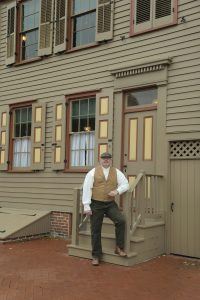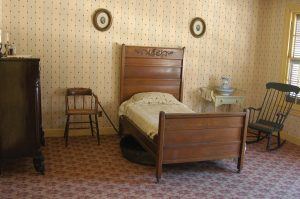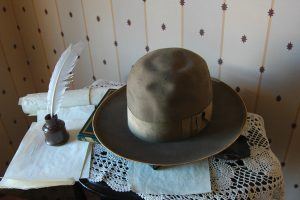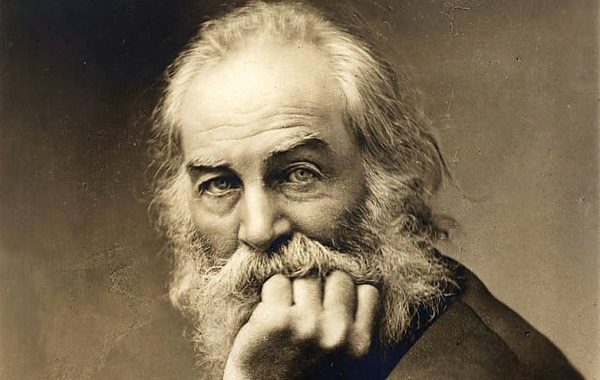Over 120 years ago, Walt Whitman died in a waterbed. The poet spent the last two decades of his life in Camden, a place he’d come to by accident, but which became a beloved and inspirational home.
Whitman’s lasting presence in South Jersey is evident, from the bridge and turnpike service area that bear his name to Camden’s City Hall, emblazoned with the poet’s line, “In a dream, I saw a city invincible.” His likeness adorns signs all over South Jersey, and a statue of him is a landmark on the Rutgers-Camden campus. But nowhere is the legacy of the “Good Gray Poet” more apparent than in an unassuming two-story house on Mickle Boulevard.
Whitman, a Long Island native, first came to Camden in 1873 to visit his brother George and their ailing mother. Though his mother, Louisa, died a few days after he arrived, Whitman stayed on, living with his brother until 1884, when George moved to Burlington and Walt purchased the small house on Mickle Boulevard for $1,750.
The property was not in great shape; it had no furnace and needed extensive repairs, but Walt felt drawn to it. In April of 1884 he wrote to friend and fellow writer Anne Gilchrist, “I have moved into a little old shanty of my own…am much more contented.”
The house remained in Whitman’s family after his death in 1892. In the 1920s, the Walt Whitman Foundation acquired the property from a niece of the poet’s.

Curator Leo Blake is devoted to preserving Whitman’s legacy in Camden
“The house was designated a state historical site in 1948, but it has a lengthy history going back long before that,” says Leo Blake, curator of the Walt Whitman House.
In fact, efforts to preserve Whitman’s home began much earlier. Horace Traubel, Whitman’s friend, a Camden native and the author of nine volumes titled “Walt Whitman in Camden,” mounted an unsuccessful campaign the same year Whitman died to purchase the property. In 1921, after the property was reacquired, Dr. Alexander McAlister, Whitman’s personal physician, formed the Walt Whitman Foundation in order to furnish and preserve the house.
The foundation’s efforts to collect artifacts from the neighborhood paid off, and today the home is full of original furniture, including Whitman’s rocking chairs and his waterbed. It is also home to a number of Whitman’s possessions, from family portraits to the boots he wore in his last days.
One of the house’s most interesting artifacts, Blake says, is directly linked to McAlister himself. It’s a framed death notice, marked with holes where it was nailed to the home’s front door.
“It was hastily written out by the attending physician, Alex McAlister, when Walt Whitman died,” Blake says. “Apparently, when word got out, there were a lot of people and members of the press coming to knock on the door. McAlister wrote this out and nailed it to the door.”
The notice reads, in part, “Whitman began sinking at 4:30 pm. He continued to grow worse and died at 6:43 pm. The end came peacefully. He was conscious until the last.”
Another of Blake’s favorite documents is a contract, with Whitman’s signature at the bottom, which details the plans for the poet’s tomb at nearby Harleigh Cemetery.
“There’s a price at the bottom of $4,678, which was an enormous sum in 1890,” Blake says. “The money came from his fans all over the world. There was a rumor that got out that Walt Whitman was living in poverty, in squalor. That wasn’t the case at all, obviously, but his fan base – folks from all over America and in England – donated funds for him to build a house outside of Camden. Instead, he used it to build his tomb.”
Perhaps the most remarkable place in the Walt Whitman House is upstairs, in the bedroom that doubled as Whitman’s study, which has been recreated as it appeared in Whitman’s time. In one sun-soaked corner is a table overflowing with books and papers.

Whitman’s bed, purchased from a Camden waterfront furniture company, had a waterbed mattress
“It’s very much a writer’s room,” Blake laughs. “There are copies of all the papers he collected over time. There are manuscripts and letters – he had a lot of correspondence. He described this room as being like the cabin of a ship, and he often sat by the window to work.”
From that window, which looks out over Mickle Boulevard, Whitman could watch the people of Camden passing. Blake believes this was a major inspiration for Whitman’s work, including his iconic book of poetry, “Leaves of Grass,” the final edition of which was finished in Camden in 1892.
“Camden for Walt Whitman meant many things,” Blake says. “It was a city that was growing by leaps and bounds, and he was fascinated by industry and the working people here in Camden.”
Another major aspect of Whitman’s work is his vivid imagery of nature. Visitors to Camden today may not feel that they’ve stepped into a bucolic country landscape, but Blake says things have changed quite a bit over the last century.
“Nature was a hugely important part of Walt’s life here in Camden,” Blake says. “In his day, you could go up Mickle Street three blocks and there was the countryside. It wasn’t at all like the city you see today.”
Though times have certainly changed – the house is flanked by weedy vacant lots, and the view from the front windows is blocked by the barbed wire of the Camden County Jail – Blake says a bit of Whitman’s natural inspiration is preserved in the house’s backyard, where a well-tended garden overflows with colorful flowers and fragrant trees each spring.
“We keep this little piece of the nature Walt loved so much in his garden,” Blake says. “It was an inspiration for Walt Whitman during his life, and it continues to be an inspiration for many who come to visit here today.”

The Walt Whitman House is full of the poet’s personal items, collected and preserved after his death
And many do visit. In fact, Blake says, tourists and Whitman devotees come from all over the world to see the home where Whitman lived and died. Tours are available throughout the year from Wednesday through Saturday, and Blake often shows the home to school groups. He says many people find Whitman interesting, even in modern times, because of the mark the writer left on poetry.
“He broke all the conformity of what a poem was supposed to be with rhyme and meter,” he says. “He is the grandfather of free verse and very important to readers and writers alike.”
Even locals with less interest in literature come to visit, Blake says, out of respect for Whitman’s impact on South Jersey and his abiding love for Camden.
“When asked, ‘Why Camden?’ Whitman said it was an accident,” says Blake. “But he said, ‘I shall never be sorry I was left over in Camden. It has brought me blessed returns.’”












